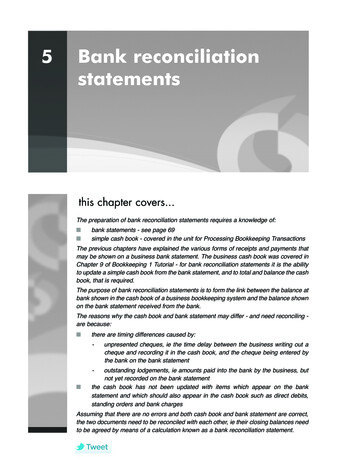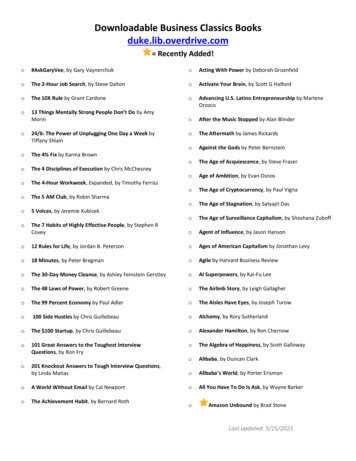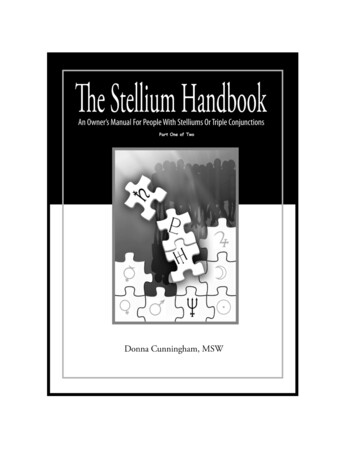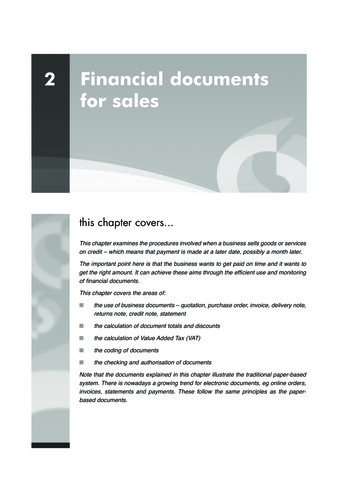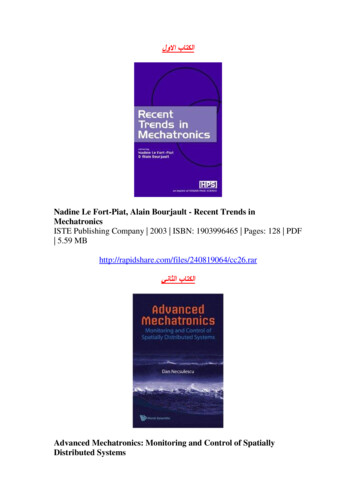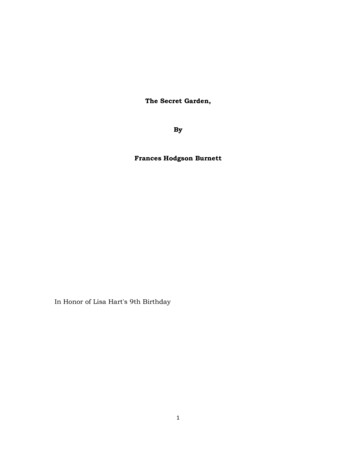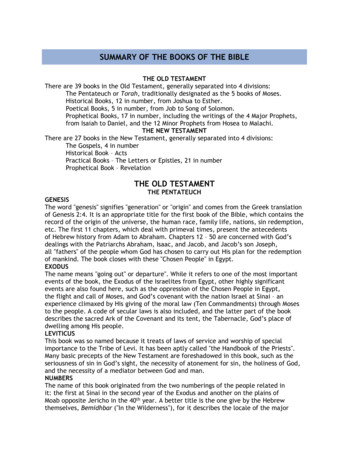
Transcription
SUMMARY OF THE BOOKS OF THE BIBLETHE OLD TESTAMENTThere are 39 books in the Old Testament, generally separated into 4 divisions:The Pentateuch or Torah, traditionally designated as the 5 books of Moses.Historical Books, 12 in number, from Joshua to Esther.Poetical Books, 5 in number, from Job to Song of Solomon.Prophetical Books, 17 in number, including the writings of the 4 Major Prophets,from Isaiah to Daniel, and the 12 Minor Prophets from Hosea to Malachi.THE NEW TESTAMENTThere are 27 books in the New Testament, generally separated into 4 divisions:The Gospels, 4 in numberHistorical Book – ActsPractical Books – The Letters or Epistles, 21 in numberProphetical Book – RevelationTHE OLD TESTAMENTTHE PENTATEUCHGENESISThe word "genesis" signifies "generation" or "origin" and comes from the Greek translationof Genesis 2:4. It is an appropriate title for the first book of the Bible, which contains therecord of the origin of the universe, the human race, family life, nations, sin redemption,etc. The first 11 chapters, which deal with primeval times, present the antecedentsof Hebrew history from Adam to Abraham. Chapters 12 – 50 are concerned with God’sdealings with the Patriarchs Abraham, Isaac, and Jacob, and Jacob’s son Joseph,all "fathers" of the people whom God has chosen to carry out His plan for the redemptionof mankind. The book closes with these "Chosen People" in Egypt.EXODUSThe name means "going out" or departure". While it refers to one of the most importantevents of the book, the Exodus of the Israelites from Egypt, other highly significantevents are also found here, such as the oppression of the Chosen People in Egypt,the flight and call of Moses, and God’s covenant with the nation Israel at Sinai – anexperience climaxed by His giving of the moral law (Ten Commandments) through Mosesto the people. A code of secular laws is also included, and the latter part of the bookdescribes the sacred Ark of the Covenant and its tent, the Tabernacle, God’s place ofdwelling among His people.LEVITICUSThis book was so named because it treats of laws of service and worship of specialimportance to the Tribe of Levi. It has been aptly called "the Handbook of the Priests".Many basic precepts of the New Testament are foreshadowed in this book, such as theseriousness of sin in God’s sight, the necessity of atonement for sin, the holiness of God,and the necessity of a mediator between God and man.NUMBERSThe name of this book originated from the two numberings of the people related init: the first at Sinai in the second year of the Exodus and another on the plains ofMoab opposite Jericho in the 40th year. A better title is the one give by the Hebrewthemselves, Bemidhbar ("In the Wilderness"), for it describes the locale of the major
events of the book. In all these events, the writer sees the guiding hand of God,sustaining, delivering, and keeping covenant with His people, as He prepares them forentrance into the land promised first to Abraham in Genesis 12.DEUTERONOMYThe final book of the Pentateuch derives its English name from the Greek workdeuteronomion, meaning the "second law", or the "law repeated". Deuteronomy iscomposed of Moses’ farewell addresses to a new generation in which he summons themto hear the law of God, to be instructed in the application of its principles to the newcircumstances awaiting them, and to renew intelligently the covenant God had madewith their fathers – a covenant that must be faithfully observed as the condition of God’sblessings upon them in the Promised Land.THE HISTORICAL BOOKSJOSHUAThis book serves as the connecting link between the Pentateuch and the later historicalbooks; it name is derived from the principal character, Joshua. Chapters 1 to 23 describethe conquest of the land and it division among the tribes of Israel. In the final chapters(23-24), Joshua, somewhat after the fashion of Moses, exhorts the people in a series offarewell addresses "to keep and to do all that is written in the book of the law of Moses,"and solemnly challenges them to the renewal of their covenant commitment to God.JUDGESNamed after the "Judges of Israel," the heroic leaders whose deeds it records, thisbook covers a period of time from the death of Joshua to the birth of Samuel, an eraoften called "the dark ages" of Hebrew history. Here is a story, on the human side, ofdisobedience and disaster, and on the divine side, of direction and deliverance. Of the 13judges named, only 3 are well known: Deborah, Gideon, and Samson.RUTHThe Book of Ruth offers a striking contrast to the Book of Judges, but its story isassociated with the same period. In Judges, national sin and corruption portray a darkpicture. The story of Ruth the Moabitess and her loyalty and devotion to Naomi, herHebrew mother-in-law, presents the reader with a picture of the nobler side of Hebrewlife in the days of the judges.I and II SAMUELThese books were named after Samuel, not only because he is the principal figure inthe first part, but also because he anointed the two other principal characters, Saul andDavid, as the first to kings of Israel. Originally a single book which was divided whentranslated into Greek, the books of Samuel cover a period of time in Israel’s historyfrom the birth of Samuel to the close of the reign of David. First Samuel presents thetransition from Israel’s judges to the monarchy. Second Samuel deals almost exclusivelywith the history of David and presents a vivid picture of the theocratic monarchy in whichthe king represents God’s rule over the people.I and II KINGSThese books are the sequel to I and II Samuel and should be read as a continuation of thehistory of the Hebrew nation contained in the former work. Originally one book, I andII kings relate the history of Israel from the last days of David to the destruction of thenorthern kingdom, Israel, in 721 B.C., and to the fall of the southern kingdom, Judah, in586 B.C. This is the period of Israel’s glory, division, decline, and fall.I and II CHRONICLESIn the Hebrew Canon these books formed a single volume called "Things of the days"
(i.e., annals). The translators of the Greek Septuagint Version gave them the title,Paraleipomena, meaning "things left over", implying their use as a supplement toSamuel and Kings. Jerome (c. A.D. 340-420) called them "a chronicle of the whole andsacred history" from Adam to Cyrus (538 B.C.), hence their English name. Chronicles is asummary of Hebrew history that duplicates much of Samuel and Kings, focusing more onGod’s guidance of the kings descended from David.EZRA and NEHEMIAHWritten originally as one book, these two books describe the return of the Jewish exilesafter 70 years of bondage in Babylon, and the subsequent restoration of Jerusalem, itsTemple and it walls. Ezra and Nehemiah are of special importance, since they containnearly all of the direct information known of the post-Exile period of Hebrew history.ESTHERThe Book of Esther, in the form of a short story similar to the Book of Ruth, has itssetting in the palace of Shushan, or Susa, one of the three capitals of the PersianEmpire. The story gives us a vivid picture of the Jews in exile, of the hostility of theirnon-Jewish enemies in Persia, and of how Esther became the queen of Ahasuerus(Xerxes), subsequently risking her life in order to save her people, the Jews, from totaldestruction. God’s providential care of His people is magnified throughout, though theword "God" never appears in the book.THE POETICAL BOOKSJOBSo named from Job, its chief character, the book deals with an ageless question, onethat is puzzling to every generation – the problem of human suffering, particularly theaffliction of the righteous. The reader is given an account of the sufferings of the piousPatriarch Job, of the argument carried on between Job and his friends as to the cause ofhis sufferings, and finally, of the solution to his difficulty,. The book’s principal aim is torefute the popular view that all suffering is the result of sin in the life of the sufferer.PSALMSA collection of 150 psalms, who Hebrew name is "The Book of Praise". Authors ofindividual psalms include David, Solomon, Moses, Asaph, the “sons of Korah”, and otherswho are anonymous. The variety and unity of Psalms have given this book a unique placein the devotional life of the individual and the Church. Almost every aspect of man’srelation to God is depicted in these poems: simple trust, the sense of sin, appeals to ahigher power in time of trouble, and the conviction that the world is in the hands of aloving God.PROVERBSThis book is a compendium of proverb collections. Although Solomon inspired thedevelopment of the book, its entire content did not derive from him. A proverb is ashort, pithy saying with practical implications. The ones included here cover a varietyof subjects, for example, chastity, control of the tongue, laziness, knowledge, relationswith others, justice. Perhaps above everything else in Proverbs there is the reiteratedassertion that the source of true wisdom is "the fear of the Lord".ECCLESIASTESIn English, the title means "Preacher". It is traditionally held to have been written bySolomon. The author’s purpose is to prove the vanity of everything "under the sun".This truth is first announced a fact, then proved from the "Preacher’s" experience andobservations. Finally, the author shows that the fullness of life is found only in therecognition of things "above the sun", things spiritual as well as material.
THE SONG OF SOLOMONThis book, the only one in the Bible that has love for its sole theme, is a collection orcycle of marriage songs. As with Ecclesiastes, the composition is about Solomon, and isprobably by him. The Song is didactic and moral in its purpose, and has traditionally beeninterpreted as showing God’s love for His Chosen People and Christ’s love for His Bride,the Church.THE FOUR MAJOR PROPHETSISAIAHThis book, as is true of all the prophetical books, derives its name from the prophetwhose messages it records. The unity of Isaiah, a problem related to authorship andcontents, has been the subject of much debate. There is probably a period of a fewdecades between the writing of the first 39 chapters and the latter 27. Each sectioncarries its own message: judgment upon Judah for her sins (1-39), and comfort and hopefor an exiled people (40-66). In these messages of encouragement are found some of themost graphic portrayals of the Messiah in the Old Testament.JEREMIAHJeremiah was God’s spokesman during the decline and fall of the southern kingdom,Judah. Among the Prophets not one had a more difficult task than that of standing alonefor God in the midst of the apostasy of his own people, and not one who bares his soulto his reader as does Jeremiah. Although Jeremiah announced the coming destruction ofJudah, he looked beyond this judgement to a day when faith, no longer national, wouldbe individual and spiritual. This new kind of faith would result from God’s "new covenant"with His people.LAMENTATIONSEntitled in most English versions The Lamentations of Jeremiah, this book is placedimmediately after Jeremiah. The book is composed of five poems, lamenting the siegeand destruction of Jerusalem (586 B.C.). The poet also makes sincere confession of sinon behalf of the people and leaders, acknowledges complete submission to the will ofGod, and finally prays that God will once again smile upon His people and restore themto their homeland.EZEKIELEzekiel was a priest carried into exile in Babylon, where he received his call andexercised his prophetic ministry. His dual role of prophet-priest and his positionas "watchman" over his people make Ezekiel unique among the prophets and may accountfor the uniqueness of his message and his methods of delivery. The book contains 48chapters, divided at the halfway point by the fall of Jerusalem. Ezekiel’s propheciesbefore this event are chiefly messages of condemnation upon Judah for her sin; followingthe city’s fall, the prophet speaks to helpless people of the hope and certainty ofrestoration to their homeland and of worship again in the Temple.DANIELWritten by the Prophet Daniel in exile in Babylon during the 6th century B.C. this bookcontains the best-known predictions of the restoration of Israel, the history of thenations, and the end of the age. In a series of events and visions, the author presents aview of history in which God rules and prevails over men and nations to achieve ultimatevictory for the "saints" of God.THE TWELVE MINOR PROPHETSHOSEA
Sometimes called the "Prophet of Divine Love," Hosea was a native of Israel and wascalled to be God’s spokesman during that kingdom’s darkest hour. The apostasy ofhis own people was enough to break Hosea’s heart, but he also bore a heavy cross inhis own life – his wife had proved unfaithful. In this bitter experience Hosea came tofathom God’s love for his erring children and pleads with his people to repent and availthemselves of God’s divine compassion and a love that will not let Israel go.JOELTraditionally called the "Prophet of Pentecost," since his prophecy of the outpouring ofthe Spirit (2:28ff.) is quoted by Peter (Acts 2:16) as being fulfilled at Pentecost, Joel wasthe kind of man who could see the eternal in the temporal. The occasion of his messagewas a devastating locust plague, which he interpreted as foreboding the Day of theLord when God would act directly to punish His people for their sins. Joel calls upon thepeople of Judah to repent, promising that repentance will bring God’s blessings, bothmaterial and spiritual.AMOSAmong the "writing" prophets Amos was the first of a new school, for, like Elijah andJohn the Baptist, he denounced sin with rustic boldness. A shepherd and native of Judah,he was called by God to prophesy to the northern kingdom of Israel during the reignof Jeroboam II (786-746 B.C.). Sparing no one, the prophet fearlessly announced theimpending judgment of God. Although the dominant note of the book is judgment, thefinal words promise the restoration of a righteous remnant.OBADIAHThis shortest of the prophetic books, containing only 21 verses, is a scathing denunciationof the Edomites, descendants of Esau, who from the beginning had been hostile to Israel.Its message is primarily one of destruction and doom for Edom. The latter part of theprophecy is concerned with the Day of the Lord when God’s judgment will be upon othernations as well as Edom and concludes with the promise that "the kingdom shall be theLord’s".JONAHThe Old Testament counterpart of John 3:16, this book declares the universality ofGod’s love embracing even pagan nations. The author relates how Jonah refused God’scall to preach to the people of Nineveh, his punishment for this disobedience, hisready response to a second summons, and his bitter complaint at God’s sparing the cityfollowing her repentance. Christ Himself alludes to Jonah when speaking of His owndeath and Resurrection (Matt. 12:39, 16:4; Luke 11:29-32).MICAHThe Prophet Micah was a younger contemporary of Isaiah and spoke at a time whenconditions in Judah paralleled those in the northern kingdom of Israel during Amos’day. Micah’s messages are strikingly similar to those of Amos: many of the same sins aredenounced and the same rugged, direct, indignant, and convincing language is used.While announcing God’s certain judgment upon sin, he also spoke of a sure deliverance tocome through the Messiah whose place of birth he predicts.NAHUMThis book is a vivid prediction of the approaching downfall of Nineveh, the capital city ofAssyria, one of the most warlike of the ancient heathen nations. Of the Prophet Nahum,whose name means "consolation" or "comfort", little is known. His purpose was to comforthis people, long harassed by Assyria, with the promise that this cruel and oppressingpeople would soon meet destruction at God’s hand.HABAKKUK
While this book is true prophecy, its method is quite different from other writings ofthe prophets. Dramatically constructed in the form of dialogue, this book contains theprophet’s complaints (questions) and God’s reply to them. In God’s answers Habakkukdiscovers the doorway leading from questioning to affirmation, through which he entersinto a faith that enables him to affirm, "I will rejoice in the Lord God, the Lord, is mystrength."ZEPHANIAHThis book, though brief, is comprehensive, embracing the two great themes of propheticteaching: judgment and salvation – both extending to all nations. In some greatcatastrophe of his day, perhaps the Scythian invasion (c. 626 B.C.), Zephaniah sees God’sterrible judgment upon the nations, including Judah. He exhorts the people to repentand assures them that God will dwell in the midst of a righteous remnant followingrepentance.HAGGAIThis book, the first among the writings of the post-Exile prophets, consists of fourprophecies delivered within the space of 4 months, some 15 years after the return of thefirst exiles to Jerusalem. Work on the second Temple has begun shortly after the exiles’arrival, but had been delayed for almost two decades. Haggai comes forward with aseries of timely and vigorous messages challenging the people to respond wholeheartedlyto a noble task – rebuilding the House of God.ZECHARIAHSometimes called the "Apocalypse of the Old Testament", this book contains themessages of the Prophet Zechariah, a contemporary of Haggai. The main division of thebook (1-8, 9-14) are noticeably dissimilar in both style and subject matter. The firsteight chapters are primarily concerned with the rebuilding of the Temple, although thelanguage used is highly symbolical. Chapters 9 to 14 deal with "last things", the "endtime". Many Messianic references are found, and the writer foresees the Day of the Lordwhen Israel will be restored, the nations judged, and God’s kingdom triumphant.MALACHIThe name of the last book of the Old Testament and of the Prophet whose oraclesit contains, Malachi ( from Hebrew meaning "my messenger") is an invaluable sourceconcerning the Judaean Jews during the Persian period. Two themes are predominant:the sin and apostasy of Israel (1-2); and the coming judgment upon the faithless, withblessings promised for those who repent (3-4). The growing Messianic expectation in theOld Testament is apparent in Malachi by the announcement of God’s "messenger of thecovenant", by whose coming Israel will be purified and judged; and of the return of theProphet Elijah who will proclaim the Day of the Lord.THE NEW TESTAMENTTHE GOSPELSMATTHEWFrom at least the 2nd century A.D., the Gospel of Matthew has been ascribed to Matthewthe publican, tax collector, and disciple. It is the most complete account of Jesus’teachings and was written to convince the writer’s Jewish audience that Jesus was theMessiah descended from David, the One promised by the Old Testament Prophets. Itis the Gospel for Israel. The most significant teaching passages are the Sermon on theMount (5-7) and the parable sections (especially Chapter 13).MARKThe Gospel of Mark, the shortest, is also held by most to be the first of the Gospels to
be written. A tradition dating from the 2nd century ascribes this book to John Mark, acompanion of Peter and also of Paul and Barnabas in their missionary endeavors. Thepreaching of Peter may well have been the source of most of Mark’s material. Markaccounts for the ministry of Jesus from His Baptism to His Ascension. Most commentariesagree that Mark’s purpose was neither biographical nor historical, but theological: topresent Jesus as the Christ, the faithful servant of God, the mighty worker rather thangreat teacher. Hence, Mark makes fewer references to the Parables and discourses, butmeticulously records each of Jesus’ "mighty works" as evidence of His divine power. Markcontains 20 specific miracles and alludes to others. Bible scholars quite generally agreethat Mark wrote his Gospel in Rome for the gentiles.LUKEThere is almost universal agreement that Luke, the "beloved physician" (Col. 4:14) whoaccompanied Paul on his missionary travels, was the author of the third Gospel. Lukewrote to present Jesus as the Universal Savior, the perfect Man, the compassionatehealer and teacher. His careful historical approach is revealed in the preface, whichstates that the author has traced "all things from the very first". Unlike Mark, this authorincludes an account of the Virgin Birth, and unlike Matthew he extensively describes thePerean Ministry (Chapters 9-18).JOHNThe Gospel of John endeavors to explain the mystery of the Person of Christ by the useof the term "logos" (word) and was written to confirm Christians in the belief that Jesuswas the Christ, the Son of God. Its purpose is evangelical and is so stated in 20:31. Johnnot only records events as do the other Gospels but also uniquely interprets the eventsby giving them spiritual meaning. The author makes significant use of such words as light,water, life, love, and bread. Traditionally the author of this Gospel is considered to havebeen John, the Beloved Disciple.HISTORYACTSAddressed to a certain Theophilus, about whom nothing is known (1:1), the Book of Actsrecords the early history of the Apostolic Church. Beginning with the Ascension of Jesusto heaven, it traces the growth of Christian faith in Palestine and its spread to Syria, AsiaMinor, Greece, and eventually to Rome. The leading figure in the first chapters is Peter,who delivered the stirring sermon on the day of Pentecost (2). The greater part of thebook, however, is devoted to the experiences of Paul and his companions during theirmissionary endeavors. The Book of Acts provides a useful background for study of thePauline Epistles. The introduction (1:1) attests to a Luke’s authorship.EPISTLESPauline EpistlesROMANSThis letter, the first in canonical order, but not the first of Paul’s Epistles, is the longestand the most influential of all the Apostle’s writings. Writing to Christians at Rome whomhe hoped soon to visit, Paul presents to them his mature convictions concerning theChristian faith: the universality of sin; the impotence of the law as a means of salvation;the nature of God’s saving act in Christ, and its appropriation by faith. The letter closeswith spiritual advice and some personal remarks.I CORINTHIANSThis letter discusses doctrinal and ethical problems that were disturbing the Corinthian
church, and presents a picture of the life of a particular local congregation in NewTestament times. Writing from Ephesus, where he spent at least three years, Pauladdresses the Corinthian church concerning the significance of the new life in Christ,which should be demonstrated in the fellowship within the Church. He advises themregarding spiritual gifts (12), Christian love (13), and the meaning of the Resurrection(15).II CORINTHIANSOften called "the hard letter", this is an intensely personal letter. It recounts thedifficulties and hardships Paul has endured in the service of Christ (10-13). The Apostleregards the Corinthians as his children in Christ.GALATIANSPaul’s letter addressed to the churches in Galatia is the great letter on Christianfreedom; in it Paul attacks the Christians who wished to exalt the law. Galatians’emphasis is similar to the theme of Paul’s letter to the Romans. The doctrinal section, asis typical of the Pauline format, is followed by an intensely practical section in Chaptersfive and six.EPHESIANSThe Ephesian letter is one of Paul’s four "Imprisonment Letters" – Philippians, Colossians,and Philemon being the others. Although addressed to the church in Ephesus, this letteris generally believed to have been a circular discussing the believers’ exalted positionthrough Christ, the Church as the body of Christ, her relationship to God, and practicalimplications of the Gospel.PHILIPPIANSIn this letter, which is a message of joy, Paul expresses his gratitude for the Philippians’love and material assistance. The Epistle is uniquely significant because of itspresentation of the humility of Jesus. Its practicality is also observed in Paul’s advice totwo feuding women, Euodia and Syntyche.COLOSSIANSThe Colossian letter is well known for its doctrine as well as for its brevity. In the letter,Paul insists upon the Lordship of Christ. Colossians is important also because of itsreferences, implied or actual, to incipient Gnosticism, a growing heresy in the Church.I AND II THESSALONIANSThese letters constitute what is probably the earliest writing of the Apostle Paul. Therewere written in A.D. 51-52, soon after the founding of the Thessalonian church, andgive Paul’s answer to some basic problems disturbing the Christians of Thessaloniki. Themajor contributions are eschatological, investigating especially the events precedingand accompanying the return of Christ. The concern of Paul for his followers is apparentthroughout.I AND II TIMOTHYAlong with the letter to Titus, these writings are defined as "pastoral epistles", whichapproach the material from the perspective of the minister, not of the Church. Theletters to Timothy discuss such matters as the duties and qualifications of churchofficers, the inspirations of Scripture, the treatment of widows, and the expectation of afuture reward.TITUSThis is a personal letter written by the Apostle Paul to a young minister whom he had lefton Crete. Like the Timothy correspondence, the letter to Titus is practical and discussesthe everyday problems confronted by a young minister. This letter was probably writtenbetween the first and the second letters to Timothy.
PHILEMONThis shortest of all Paul’s letters was addressed to Philemon (although two other personsare included in the salutation). Paul entreats Philemon, the master of Onesimus, arunaway slave, to receive him back as a brother in Christ (16, 17). This very personalletter reveals not only the concern of the Apostle for a converted slave but also apractical demonstration of brotherhood in Christ, "where there is neither bond (slave) norfree". (Gal 3:28)HEBREWSTradition ascribes Hebrews to Paul, though some believe it to have been written bysomeone other than the Apostle, someone who was deeply acquainted with Paul’steaching. The Epistle portrays Jesus, who performed the perfect sacrifice for the sins ofthe world, as the great High Priest of the line of Melchizedek (Gen. 14). The Bible’s onlydefinition of faith occurs in this Epistle (Chap. 11) and is followed by the "great line ofsplendor" of the men of faith. Its key word is "better".General EpistlesJAMESThe author of this letter introduces himself as "James, a servant of God and the LordJesus Christ". Four men in the New Testament bore this name but the writer of thisEpistle is usually identified with James who was the leader of the church in Jerusalem.The letter is addressed to the "the twelve tribes which are scattered abroad", and is themost Jewish in style and form of any of the New Testament books. It is not a treatiseon Christian theology but rather a practical letter dealing with Christian ethics. Jamesinsists that works, not words, are the mark of a disciple.I PETERThe author describes himself as "Peter an apostle of Jesus Christ", and there is no reasonto doubt the truth of his claim, although the beautiful Greek style employed has ledsome scholars to believe that the writing may have been edited by an associate (probablya secretary). The contents breathe the spirit of Peter. His speeches recorded in Actsindicate a similar attitude toward persecution and suffering. The letter here reflectsa time of suffering and trial. No doubt the widespread persecution of the Christians bythe Roman authorities was the occasion of the "fiery trial" (4:12). The writer admonisheshis readers to a life of purity, of godly living, and exhorts them to steadfastness andfaithfulness.II PETERThis letter was a "reminder" to the readers of the truth of the Gospel, which they hadreceived as against the attacks of false teachers who would pervert it. The author urgeshis hearers to remain steadfast even amidst persecution and reminds them that the Lordwill keep His promises. He speaks of the "day of the Lord" (parousia or “presence”) and ofthe necessity of keeping themselves "without spot and blameless" (3:14)THE EPISTLES OF JOHNThree Epistles by John – I, II and III John – are included in the New Testament. TheseEpistles should probably be dated A.D. 90-95. John, the author of the Fourth Gospel,addresses the first one to an unidentified group. I John 5:13 indicates that the authorwrites in order that this group might know the certainty of eternal life. II John isaddressed to an elect lady, either a church or perhaps a woman. III John is addressed toGaius, a man commended for his hospitality.JUDEThe author of this short letter warns his readers against the dangers of apostasy, and
points to the faithlessness of the Israelites as a reminder of God’s judgment. Surroundedas his readers were by moral corruption and apostatizing influences, the author urgesthem to "contend for the faith" (3), and in a closing benediction he commends them tothe One "who is able to keep you from falling" (24). Both the similarity of this letter toII Peter and Jude’s use of non-Biblical sources (9,14,15) have been the subject of muchdiscussion.PROPHETICAL BOOKREVELATIONThis last book of the Bible identifies itself as "the revelation of Jesus Christ", and itsauthor is designated "his servant John" who was exiled to the Greek island of Patmosbecause of his faith. Traditionally, John is identified with the author of the FourthGospel. Addressed to seven historical churches in Asia Minor, the Book of Revelation waswritten to warn against spiritual indifference and to elicit courage under persecution.Because of the extensive use of symbolism and picturesque imagery, its interpretationhas posed many problems for the student of the Bible. While recognizing the historicalsituation (Roman persecution) that elicited this writing, m
nearly all of the direct information known of the post-Exile period of Hebrew history. ESTHER The Book of Esther, in the form of a short story similar to the Book of Ruth, has its setting in the palace of Shushan,

